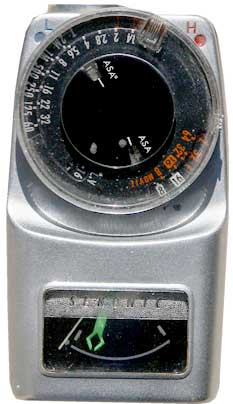
|
  Maker: Sekonic Model: L-88 "MicroLite" Circa: 1961 - 1963 Cell type: CdS Measure type: Reflecting/Averaging Price (new): $24.95 Original Battery: 1.35V H-N Modern Battery: Small Battery Company MR-52 Adapter |
|
Sekonic claims that this is the world's first. It may be. An issue of the US magazine Modern Photography from the time lists three that came about around the same time: this, the Gossen Luna-Pro, and the Pentax 3/21. This was named the Microlite, where micro is meant for low-light measurement, not small meter size. The big advantage of CdS was its ability to measure much lower light levels than selenium cells. The big drawback was that it required batteries. At the time it wasn't very important; but these meters used 1.35volt mercury cells and the meters usually aren't voltage regulated inside. So 50 years later you can't get those mercury cells anymore—you have to buy an "equivalent" which has the wrong voltage (usually a tad higher), and that throws the meter readings off a bit. |
|
©opyright by James Ollinger. All Rights Reserved.
Company names and models are registered trademarks of their respective owners
and are not affiliated with this website in any way.

.jpg)